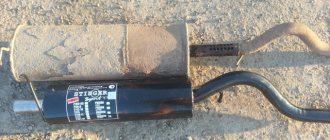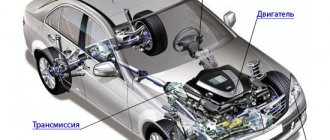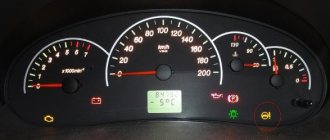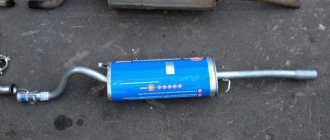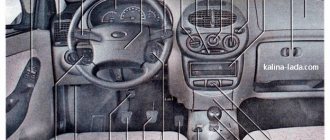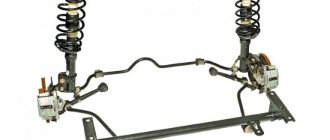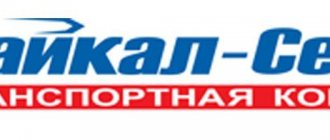If the owner of a Lada Kalina car has discovered the presence of extraneous knocks in the front suspension, then in this case a thorough diagnosis of the entire chassis will be required, and probably repairs; sometimes replacement of silent blocks will be required. Increased wear of suspension components is primarily caused by the well-known condition of domestic roads. Next, we’ll talk about the front suspension design.
Front suspension device
The front suspension of the Lada Kalina is independent on MacPherson struts. This suspension is the most common in the automotive world for its price and acceptable characteristics for this price. Previously, Lada used this suspension, for example, in Lada Samara, but it was much poorer in equipment than MacPherson, although it was 90% similar to it.
So, the Lada Kalina suspension consists of the following components:
- Stabilization bar;
- Brackets for securing the stabilization rod;
- Cross arm mountings;
- Front suspension arm;
- SPU (anti-roll bar) bases;
- Telescopic front suspension strut;
- Ball-shaped supports;
- Kulaga;
- Longitudinal stretch;
- Stretch mounts.
Interior tuning
Drivers resort to interior tuning to improve the comfort and convenience of the driver and passengers in the car.
Not only the front row and instrument panel, but also the rear seats may be subject to modernization.
The original sound insulation of the Lada Kalina is of extremely low quality. Therefore, when tuning the interior, drivers cover the surfaces with sound-absorbing material.
Suspension device Lada Kalina
The suspension includes coil-type and conical springs, they are not in the photo. The springs are located above the suspension strut. Thanks to them and the shock absorber, the car's ride and handling are ensured. The spring is made of steel with a low carbon content; it softens shocks, bumps and bumps. When the car hits an obstacle, the wheel becomes virtually completely out of control, which is a problem. A spring is needed to return the wheel to its place. A shock absorber is necessary to dampen vibrations after the wheel returns to its normal position. The front suspension arm removes the roll and holds the wheel on itself, and the front suspension arm is also an element of setting the wheel in its place when hitting obstacles. The SPU strut is necessary to connect the body and suspension. This element equalizes the vibrations of the body and suspension, which allows the car to move without problems with tilting when turning.
Body tuning
Body styling allows you to change the appearance of the Lada Kalina the most. The cost of such modernization ranges from 1 to 300 thousand rubles. It all depends on the number of parts and materials purchased, as well as on the method of tuning.
First of all, during modernization, an aerodynamic body kit is used. Spoilers can be installed, and the bumper can also be replaced. This type of tuning requires precise calculations. Otherwise, only the appearance of the car will improve, but the dynamics will deteriorate and fuel consumption will increase.
Improving the appearance is typical not only for cars in sedan and hatchback bodies, but also for the Lada Kalina station wagon. There are a lot of spoilers, trims and sills available for sale for such a car. Their use allows you to give a sporty appearance even to a station wagon.
Airbrushing, silk-screen printing and tapography have become very popular in tuning. The cost of this type of change in the appearance of the Lada Kalina ranges from 1 to 30 thousand rubles. The price depends on the size and complexity of the design applied.
Tuning using carbon film and liquid rubber is becoming increasingly popular. Their use not only changes the appearance of the car, but also protects the paintwork from aggressive environmental influences. Other ways to change the appearance of the Lada Kalina can be found in the photo below.
Operating principle
On the Lada Kalina, MacPherson suspension has improved ride quality. Starting with Kalina, all new AvtoVAZ models began to be equipped with MacPherson strut suspension. When driving, the level of impact of a bad road on the body is much more effectively reduced, making driving a car much more comfortable than, for example, a VAZ 2109, where a similar type of suspension is installed.
Thus, the independent MacPherson suspension consists of two axle shafts, allowing the wheels to be practically independent of each other. This means that the wheels, when one of them hits a bump, a depression or something else, do not change the level of inclination, as is the norm in semi-independent and dependent suspensions.
Differences between the front suspension of Kalina and previously produced AvtoVAZ cars
All AvtoVAZ cars had a MacPherson strut suspension at the front, but it was significantly different from those used in the 70s, 80s and 90s by Ford, Fiat, Volkswagen, etc. So, the main differences between the MacPherson strut suspension and the suspensions of Lada models until 2004 are concluded as follows:
- Instead of a bearing, a bushing is mounted in the MacPherson.
- In MacPherson, the ball bearing has a larger radius, and the design also differs. Now it is located in the upper part between the support and the spring element in a compressed state, which perfectly helps to remove knocks when moving.
- When the wheels turn, the front suspension strut, or rather its body, rotates with the spring simultaneously. When this happens, the shock absorber rod remains motionless.
Rear suspension: design and features
The rear suspension beam consists of 2 longitudinal arms 13 and a connector 12, connected by means of amplifiers to each other.
Rear suspension parts: 1 – rubber-metal hinge, 2 – bracket for mounting the suspension arm, 3 – hydraulic shock absorber protection casing, 4 – buffer for the compression stroke, 5 – casing cover, 6 – support washer, 7 – shock absorber pads, 8 – spacer bushing, 9 – hydraulic shock absorber, 10 – insulating gasket, 11 – shock absorber strut spring, 12 – connector for levers, 13 – lever for the front suspension beam, 14 – bracket for fastening the shock absorber strut, 15 – flange, 16 – bushing from the lever .
Rear wheel hub and shock absorber strut mount: 1 – hydraulic shock absorber protection casing, 2 – buffer for compression stroke, 3 – support washer, 4 – insulating gasket for the spring, 5 – upper support spring cup, 6 – cushions for attaching the shock absorber rod, 10 – bolt for fastening the rear wheel hub axle, 11 – brake drum, 12 – hub bearing, 13 – hub from the rear wheel, 14 – hub axle, 15 – hub nut from the rear suspension, 16 – retaining ring, 17 – locating pin.
Location of parts from the rear suspension on the car: 1 - bracket for attaching the lever to the body itself, 2 - lever, 3 - shock absorber from the strut, 4 - lower hinge from the strut, 6 - connector for the levers, 6 - rubber-metal hinge of the lever.
In the rear part, brackets 14 with eyes are welded to the suspension arms, thanks to which you can attach shock absorber struts and flanges 15, to which the axles from the rear wheels are bolted together with the shields of the braking mechanisms. In front of the suspension arms, bushings 16 are welded into which rubber-metal hinges 1 are pressed. Bolts pass through these hinges that connect the suspension arms to brackets 2, which, in turn, are attached with studs to the power elements of the body.
The suspension springs 11 rest with one end on the shock absorber strut cup 9, and with the other, through the insulating rubber gasket 10, in the support, which is welded to the rear wheel arch of the body.
The shock absorber from the rear underseed is a telescopic hydraulic double-acting one that is attached with bolt 9 to the bracket from the suspension arm. The rod is attached to the upper support 5 from the cushion suspension spring 6 and the support washer 3.
A 2-row angular contact bearing 12 is installed in the hub 13, similar to the hub bearing in the front wheel, but with smaller dimensions. Unlike the hub in the front wheel, on which the inner ring from the bearing is installed with guaranteed interference, on the hub from the rear wheel, bearing 12 on axle 14 has a transitional fit.
lada-kalina2.ru
Knock in the front suspension of Lada Kalina
Many motorists dread the day when strange knocking noises appear in the suspension, especially the front suspension, which increases with increasing speed. Of course, there is reason to worry, but at the same time, a car’s suspension is a strong and reliable unit that will clearly withstand a few more kilometers to a service station or garage, where it can be diagnosed.
There are four main reasons for the occurrence of knocks and squeaks in the front suspension of the Lada Kalina. Of the three possible causes of knocking, two of them can be eliminated independently.
So, the first reason why a knocking sound may occur in the suspension is the quality of the road surface. Yes, suspensions, even the most ideal and new ones, can squeak and knock on a bad road, even if this has not been observed before. To test this theory, you should drive onto a well-paved road and drive a few hundred meters; if there is no knocking, everything is fine with the suspension; if not, look at the second reason.
Lada Kalina technical specifications Lada Kalina 2, dimensions, suspension, engine
The new generation Lada Kalina, in addition to a modernized appearance, also received modified technical characteristics. If the height and width of the car have not changed, then the length of the Lada Kalina 2 has become a little larger. Power units have become more advanced and, most importantly, it has become possible to install an automatic transmission. Let's begin the description of the technical characteristics of the Lada Kalina with the dimensions and dimensions of the car.
Characteristics of the Lada Kalina hatchback
- Length – 3,893 mm
- Width – 1,700 mm
- Height – 1,500 mm
- Curb/gross weight – 1160 / 1560 kg
- Base, distance between front and rear axle – 2,476 mm
- Front and rear wheel tracks – 1430 and 1414 mm, respectively
- Trunk volume up to the shelf/with seats folded – 240/550 liters
- Ground clearance of the Lada Kalina hatchback is 145 mm with automatic transmission and 165 mm with manual transmission 5 speed.
- Fuel tank size – 50 liters
- Wheel and tire size – 175/65 R14, 185/60 R14, 185/55 R15
The length of Kalina in a universal body is slightly longer. And due to the fact that the roof rails are located on the roof, the height of the station wagon is also increased. The width of the models is the same. It should be noted that the ground clearance of a car with an automatic transmission is a couple of centimeters less.
- Length – 4,084 mm
- Width – 1,700 mm
- Height – 1,500 mm (with rails 1,540 mm)
- Curb/gross weight – 1160 / 1560 kg
- Base, distance between front and rear axle – 2,476 mm
- Front and rear wheel tracks – 1430 and 1414 mm, respectively
- Trunk volume to shelf/to stream – 355/670 liters
- Ground clearance of Lada Kalina station wagon – 145 mm
- Fuel tank size – 50 liters
- Wheel and tire size – 175/65 R14, 185/60 R14, 185/55 R15
As for the transmission characteristics, the Lada Kalina has either a 5-speed manual or a 4-speed automatic. The car itself has front-wheel drive. The gear ratio of the main pair for a manual transmission is 3.7; for an automatic transmission it is 4.1.
As for power units, the Togliatti manufacturer can offer three 1.6-liter gasoline engines. This is one 8-valve engine and two 16-valve engines. At the same time, the 16-valve engine produces 98 hp. Can only be combined with automatic transmission. The characteristics of the Lada Kalina engines are below.
Engine characteristics 1.6 8-valve 87 hp
- Power hp/kW – 87/64 at 5100 rpm
- Torque – 140 Nm at 3800 rpm
- Maximum speed – 165 kilometers per hour
- Acceleration to the first hundred – 12.4 seconds
- Fuel consumption in the combined cycle – 7.0 liters
Engine characteristics 1.6 16-valve 106 hp
- Power hp/kW – 106/78 at 5800 rpm
- Torque – 148 Nm at 4000 rpm
- Maximum speed – 177 kilometers per hour
- Acceleration to the first hundred – 11.0 seconds
- Fuel consumption in the combined cycle – 6.7 liters
How to check support bearings on Kalina
Before replacing the support bearings on the Lada Kalina, you should make a diagnosis and make sure that the “support” has failed , so check out the signs of failure:
- Clicks, knocks of Kalina’s “supports” (audible under the hood, when the shock absorbers are operating);
- A cracking sound is heard from the front side under the hood (when turning);
- Handling deteriorates, play at the steering wheel increases;
- You can feel the bumps in the road through the steering wheel.
If such signs are present, then there is a 99% chance that replacing the support bearing of the Kalina front strut is inevitable, but first make a diagnosis. 1. Place the car on a flat surface and open the hood. 2. Find the upper support, press this place with your palm. 3. Rock the car from bottom to top so that the Kalina front strut supports and shock absorbers work. 4. If you feel or hear knocking noises, it means it's time to replace the support bearing. 5. Ask an assistant to rotate the steering wheel and listen to how the unit works; when in good condition, the “support” functions silently.
Lada Kalina - replacing the support bearing with your own hands
Before disassembling and removing the Kalina front strut with upper supports, be sure to study the structure of the unit. The diagram shows the serial numbers (articles) of the front suspension components.
To remove the support bearings of the front struts of the Lada Kalina you will need a set of tools: 1. A set of open-end or ring wrenches: 9, 17, 19, 22. 2. A 13 socket with a ratchet. 3. Steering wheel end puller, vice, torque wrench (if possible). 4. Jack. 5. Shock absorber spring clamps. 6. Pliers. 7. Hammer. 8. WD-40 lubricant.
How to remove the support bearing on Kalina - step by step guide
Replacing the Kalina front strut supports begins preparing the car. Place the car on a flat surface, if there is a lift or pit available. Engage first gear and release the parking brake. Dismantling sequence in order:
- We unscrew the wheel bolts, then raise the car with a jack or a lift as in our case.
- We gain access to the brake disc, but you don’t need to remove it, nor do you need to unscrew the hub locknut.
Ways to reduce the ground clearance of Lada Kalina 2
| For many owners, the lowered Kalina 2 will look much more interesting than the base one. In addition, lowering the car means attracting more attention. Do you know how to change the ground clearance of the new Kalina? |
What is the ground clearance of Kalina 2?
With a full load, the ground clearance of the new Kalina is 145-160mm, without a load it is 200mm. A car with high ground clearance can be called practical, this is especially felt in winter, when the roads in the yards are not cleared of snow, and in order to enter the parking lot you have to overcome considerable snowdrifts. In the summer, when the situation on the roads improves, you can lower the Kalina 2 and here’s how you can do it: If you expect to lower the car only in certain cases, then your choice is air suspension. It is worth noting that installing air suspension with your own hands requires not only skills and patience, but also good funding: Another way to properly lower Kalina 2 is a suspension kit with adjustable clearance. The stiffness of the shock absorbers is adjusted automatically. And to change the car's ground clearance you don't need to dismantle anything. Air suspension and suspension with adjustable clearance will allow you to make the car higher in winter and lower in summer.
The first two methods are good, but they cannot be considered cheap. The third competent way to lower Kalina 2 is a set of lowered suspension (shock absorbers and springs). Such kits are already designed for a certain understatement (-90, -120..). The relatively low cost makes this method of underestimation very popular.
To a certain extent, the clearance of Kalina 2 is affected by tires and wheels. By installing low-profile tires and alternative rims, you can achieve some effect. How correctly such tuning is carried out in conjunction with replacing standard springs and shock absorbers with lower ones (see compatibility of wheels and tires).
If you install lowered springs (or simply cut them) and do not install suitable shock absorbers, then you get many disadvantages, and only one advantage - budget. Such tuning saves time and money, but further operation of the car will still come back to haunt you.
Lada Kalina 2, lowering -90
Lada Kalina 2, lowering -120
Photo source:
Keywords:
Similar materials
xn—-8sbabr6ahc3e.xn--p1ai
How to change a support bearing without a wheel alignment on a Lada Kalina
Replacing the support bearing on Kalina without removing the strut is impossible, or will not be correct, but replacing the part without further camber is still possible. In this case, the technology for removing the rack will change:
- After removing the wheel, unscrew the hub lock nut.
- Disconnect the steering knuckle from the ball joint and steering rods.
- Then we remove the steering knuckle from the CV joint with the strut and shock absorber spring, this way you will not break the camber bolts.
Lada Kalina - front strut support bearing: choice, price, characteristics
If you do change the support bearing individually by installing it in the old support, then you should buy from trusted manufacturers, a summary table of which and photographs are presented below. Catalog number (article) - 1118-2902840.
Table of recommended manufacturers
| No. | Manufacturer | Manufacturer's code | Price 2016, rub. | Equipment | ||
| Peculiarities | Retaining rings | Protective cap | ||||
| 1 | VBF Russia Analogue | 1118-2902840-01 | 700 | — Clip made of hardened steel; — Manufactured according to GOST; — Increased service life; — High-quality lubricant. | — | — |
| 2 | NPP "System Technologies" Russia Analogue | SS10113/11180-2902840-00 | 900 | — Silence; — Vibration damping; — Work at low temperatures; — Protection from dirt and dust. | — | — |
| 3 | AvtoVAZ Russia Original | 1118-2902840 | 750 | — Original product; — 1 year warranty; - Durability. | — | — |
Table of bearing sizes 8112Н and technical characteristics
| Characteristic | Unit | Value according to GOST (TU) |
| Inner diameter of the tight ring, d | mm | 60 |
| Outer diameter of the tight ring, d1 | mm | 85 |
| Free ring inner diameter, D1 | mm | 62 |
| External diameter of free ring, D | mm | 80 |
| Installation height | mm | 17 |
| Dynamic load capacity | kH | 41,5 |
| Static load capacity | kH | 95,0 |
| Nominal speed | rpm | 3600 |
| Axial clearance | mm | — |
| Steel type | — | SHH-15 |
| Hardness of steel and rollers | H.R.C. | 61-65 |
| Contact angle | hail | — |
| Torque | kN*M | 220 |
| Ring roughness | Ra | 0.32 |
| Number of balls | PC. | 24 |
| Ball diameter | mm | 8,731 |
| Mounting chamfer radius, r | mm | 1,5 |
| Weight | G. | 295 |
Replacing silent blocks on Kalina
Front suspension silent block close up
The silent blocks on the Lada Kalina car are located exactly the same as in the VAZs of previous years. These elements are located generally on or adjacent to the wishbone . You will have to change them either on the entire element at once, or by selecting the most damaged ones. Of course, if there is damage on one of them, the wishbone with rubber (stock – approx.) stabilizers must be removed and replaced with polyurethane analogues.
Removing the wishbone
- In order to begin work on replacing old silent blocks with new ones, you need to place the car on a viewing hole, a lift, or jack it up.
- Next, you need to remove the wheel and spray all the connections on the wishbone with WD-40.
- After the lubricant has penetrated into all hard-to-reach places, we begin to unscrew the bolts.
- First of all, we begin to dismantle the ball joint bolt, but before that we remove the cotter pin from the bolt.
- Then we unscrew the bolt securing the longitudinal tension hinge (where the “daisies” are attached - approx.) and remove it from the seat.
A generously lubricated bolt is a guarantee of success.
When dismantling this unit, there should be no problems.
For the best impact on the bolt, you can use a wrench extension.
Rubber-metal longitudinal tension joint
The rubber-metal longitudinal tension joint, or popularly simply “daisy”, is designed to take the brunt of the impact from uneven road surfaces; despite the fact that this element is very important, it is very easy to dismantle.
- Having previously clamped the lever in a vice, we knock out the silent blocks one by one using a chisel or a thin flat screwdriver.
Punching out “daisies” is not an easy task.
This is what the old suspension elements look like
To cause the least damage to silent blocks, it is better to place pieces of wood between the vices.
Stabilizer strut and cushion
- The stabilizer bar, or simply “eggs,” and the cushion provide the stabilizer bar with stable operation while driving the car.
- It is very easy to dismantle the “eggs”, just unscrew the mounting bolt from the transverse arm, and simply release the other end from the anti-roll bar by simple rocking.
Sometimes it happens that they just break
After unscrewing the fastening, it is very easy to remove the pillow, but putting on a new one is much more difficult.
Cross Arm Bracket
- The largest silent block of the lever located at the very base, despite the fact that it has, among others, more impressive dimensions, is not difficult to dismantle.
- The easiest option to remove it is to set it on fire. When the rubber on it burns out, you just have to take it out and clean the seat. (Of course, you can press it out through a vice, but this will take time and may cause some inconvenience).
This way the old silent block is guaranteed to come out of its seat without any consequences.
Installing a new silent block may also take time.
Silent blocks are assembled on the lever...
...and so they are assembled on the car.
Improving the characteristics of the Lada Kalina
Having decided to implement the idea of making Kalina behave more decently on the road, the expert team did not even suspect what difficulties they would have to face at that time, and this was several years ago. At that time, this model was one of VAZ’s advanced products and had been produced for several years. But, oddly enough, many original parts were in short supply on the shelves. It seems that neither domestic nor foreign manufacturers are in too much of a hurry to produce components to “improve” the car. After a little thinking and making inquiries, the specialists nevertheless managed to assemble the components necessary for the experiment. Damping elements from the St. Petersburg Plaza and Samara enterprise Sistema Technologies were added to the standard SAAZ shock absorbers. By the way, in addition to the latter, menacingly called SS20, they received the original upper supports of the shock absorber struts, increasing the caster angle. Along with them, a stretching of the front struts was used. Since the experimental Kalina did not have electric power steering, the experts decided to install it themselves.
It was also decided to experiment with tires in order to test the behavior of the car with wheels of different sizes. For maximum correctness, we took 13-, 14- and 15-inch standard sizes of the same model - the domestic Amtel Planet-301, from which it all began.
Do inches help?
Tires 175/65R14
The budget nature of these tires is immediately felt. Apparently, during development, engineers were guided by the example of far from the most modern cars, no matter ours or foreign ones. “Kalina” behaves sluggishly and boringly on such tires. Light, but completely “empty” steering wheel, thoughtful reactions in corners and a frank desire to fall out of the bend with the front axle at the first opportunity. When sliding, the car reacts very reluctantly to turning the steering wheel and releasing the gas.
In the process of measurements on the dynamometer road, it was discovered that the brakes operate quite stably, but are not at all informative.
But on 13-inch tires the car rolls smoothly and far. The result is the lowest fuel consumption. Tires 175/65R14
By the way the interior upholstery creaked, loosened by life, you can understand that the car has become somewhat stiffer. True, a certain increase in vibration load may be a meager price to pay for the acquired integrity of reactions and unexpected activity during maneuvers, which in general are not inherent in Kalina. Even the power steering, as if having come to its senses, tried to load the steering wheel with at least some feedback. It cannot be said that the reactions are the limit of perfection, for example, in a fast turn and on a “rearrangement” the driver is still hampered by large body rolls and lags, but car control has become more reliable and understandable.
The braking distance has remained virtually unchanged, although the 14-inch tires lock up more sharply.
Despite this, a more informative pedal effort allows you to control the deceleration process much more accurately. This was unexpected, but Kalina demonstrated a very undesirable deterioration in free rolling, which does not have the best effect on fuel efficiency, although only slightly. As a result, the owner of this model can choose between saving an extra portion of gasoline or better behavior on the road. Tires 185/55R15
With these tires, the driver will be able to add both visual appeal to his car and improve its performance. She became sensitive, impulsive, obedient. The power steering also worked normally - in a sharp turn you no longer have to guess at what angle the wheels are turned. But the most important thing is that “Kalina” tracked the given trajectory almost flawlessly, which, of course, affected the “rearrangement”. The only pity is that everything cannot be perfect: the car felt every seam on the road, every pebble - in general, it thoroughly shook out the soul.
But that’s not all, because in addition it became harder to brake, because the car began to “sway” from side to side. In addition, there was a feeling that the standard brakes were not able to cope with the traction properties of the tires. The force on the pedal has increased, and jerking has appeared during intense deceleration. This may be why the factory does not recommend changing shoes to tires of this size. Fans of large rims and low-profile tires will also be upset that with them the car loses several kilometers of top speed. Fuel consumption has also increased noticeably.
Therefore, a short summary: the best tires for Kalina are those recommended by the manufacturer, namely 13- and 14-inch ones. Moreover, the latter option is optimal in terms of comfort, efficiency, stability and controllability.
Variations with shock absorbers
SAAZ shock absorbers
Before starting testing, experts installed a new set of damping elements from the Skopinsky Automotive Assembly Plant on the Kalina, which are now, in fact, the standard shock absorbers of this car. Already directly from the settings, it becomes clear that the developers have made an attempt to improve the far unenviable handling of the Kalina, which refuses to respond in a timely manner even to fairly sharp movements of the steering wheel. As the speed increases, the Kalina becomes more active and looks quite cheerful when turning and turning. But here, too, the steering speed and accuracy are lacking. Although we must give the car its due - it behaves quite logically and predictably.
However, when it comes to smoothness, things are not so clear. If the front suspension copes well with its duties, except that it harshly and noisily tracks small irregularities, then the rear one shows excessive independence. Its reaction to holes and potholes is much rougher, which is almost completely transmitted to the body. As a result, the car is rated as too rigid, despite the fact that there is even an abundance of energy reserves in the suspensions.
The operation of SAAZ shock absorbers is noted as stable.
The only drawback is the lack of balance of characteristics. It is not clear why the damping elements of the rear axle should be made so elastic. If this was an attempt to improve handling, then this begs the question: why was no attention paid to increasing vertical rigidity? “Plaza” shock absorbers
After installing the St. Petersburg shock absorbers, the front suspension became softer and more comfortable. But on gentle waves, an imposing body sway appeared and the roll increased. Before entering a turn, the car rolls in the direction opposite to the maneuver and only after that responds to steering manipulations. At the same time, the rear shock absorbers, on the contrary, try to demonstrate a tough, “plazovsky” character, collecting all the little things from the road. As a result, it feels like the front and rear axles are working separately, which does not have the best effect on handling. It also cannot be said about ride comfort - since the occupants of the cabin are quite shaken.
And all this, unfortunately, cannot be called the main drawback.
In some situations, “Kalina” became insidious: after all, “in unison” with the increased body roll, the hard rear shock absorbers began to work more actively. In fast turns there was a tendency to skid. It arises unexpectedly and develops very sharply, requiring remarkable reaction and skill from the driver in order to return the car to the trajectory. Apparently, the manufacturer would do well to pay attention to improving the characteristics. You can shift the balance towards comfort or, conversely, make the car sporty and rigid. But the main thing is not to worsen the already mediocre handling. Shock absorbers SS20
No one expected that the name “Comfort” in this case is consonant with an almost 50-point increase in force during the rebound stroke. At the same time, the option, closer in characteristics to the factory one, was called “Standard”. Be that as it may, the manufacturer has every right to do this. At the time of the test, these shock absorbers were just being prepared for serial production, so the expert team was honored to be the first to test these products.
It should be noted that the car has become dense, elastic and, perhaps, more logical. At low speeds, it follows the profile of the road in detail, carefully shaking riders on bumps almost invisible to the eye. But this kind of sportiness is not perceived by the body as discomfort, since the car has become solid. “Kalina” does not hide from the driver absolutely all the bumps that it has to overcome with the front wheels, but it also does not transmit to the interior everything that the rear wheels have to deal with. The suspension evenly distributes the amplitude of body movements between the wheels. But the energy intensity is beyond praise, and the car behaves stably at high speed.
Body roll has decreased quite noticeably, however, at the same time, the rear axle has ceased to participate in maneuvers - during fast turns, the car does not strive to return to its original trajectory. The same problems occur on the “rearrangement” - at speeds close to the maximum, the driver is hampered by the sliding of the front axle. We hope the developers will listen to our recommendations and work some more magic on the characteristics.
Despite the presence of certain disadvantages, the SS20 shock absorbers proved to be the best option out of the three tested sets. “Kalina” with these dampers on poor-quality surfaces is still comfortable and does not pose a danger during maneuvering.
Caster replacement
This problem can be solved with the help of non-standard front strut supports produced by the Sistema Technologies company. When compared with the original parts, the Samara support’s mounting point is moved back, which is why the longitudinal angle of inclination (caster) has increased. According to AVTOVAZ recommendations, this angle should not exceed +1.5°, but in this case it increased to +2.5°, and this value is quite normal for modern cars.
“Kalina”, apparently, benefited from such manipulations, because she became clear, solid, assertive in control, which had a positive effect on the top speed when performing a “rearrangement” (faster by 1.1 km/h). But the main advantage was a significant increase in steering information content.
Hardness test
The stretch in this test was one of the few parts that could be found without any problems. As tests have shown, unlike the “ten”, it does not particularly affect the behavior of the “Kalina”. The car only slightly increased the speed of passing the “rearrangement”. As a result of this, we can conclude that the model’s body is quite rigid and does not require additional strengthening measures.
To the question of how to improve the dynamic characteristics and comfort of the Lada Kalina, the answer is as follows: installing 14-inch tires, increased caster and SS20 shock absorbers.
Important!
If during the work you find that the bolts and nuts are in poor condition (there are cracks, traces of severe rust, bad threads - approx.), then it is best to replace such elements with new ones, using high-quality steel bolts and nuts with a self-locking element .
Other front suspension elements
The remaining elements of the front suspension, which contain rubber-metal and metal hinges, are replaced immediately as an assembly. These include:
- Spherical bearing.
- Stretch bracket.
- Steering end.
These elements cost about 500 rubles per set, and also do not require specific installation skills.
Causes of knocking in the front suspension
In total, there are four main reasons why noises and squeaks can annoy the Lada Kalina car owner, and three of them can be eliminated independently and everything can be returned to a safe state.
- The first reason why knocking occurs in the suspension is the poor quality of the road surface . A suspension that is in good working order can also produce some extraneous noise. If the noise disappears when you drive onto a good road, then everything is fine with your suspension, you can move on to the point below.
- If knocking and simultaneous vibration occur in the steering wheel, the reason may lie in a faulty steering rack . If you can tighten the steering rack yourself, then it is better to entrust its repair or replacement to professionals.
- The third reason is the front suspension strut spring that has lost its elasticity . Since the spring tone is significantly reduced, the suspension hits directly against the body. How to change the front struts, and along with it the spring, is described in detail in this article.
- And the last reason is cracked silent blocks, which are simply necessary to thoroughly dampen knocks and vibrations that occur while driving. Read below for information on how to properly replace these front suspension elements.
